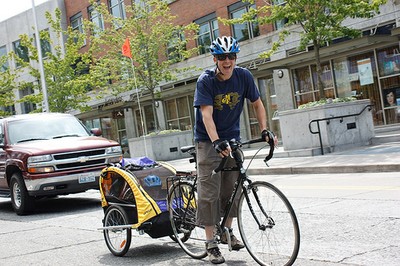My 1994 Oregon-made Burley bike trailer-stroller (above) is still dear to my heart, but innovations in newer Burleys and in other companies’ offerings show that tools for human-powered urban mobility are developing at a rapid clip. The 31-year-old Eugene company Burley and four manufacturers outside the Northwest offer bike trailer-stroller-cart-jogger hybrids that convert into so many mobility tools they are like something out of Transformers.

Almost every Burley model is quickly convertible from a bike trailer to a stroller/cart. (Sightline trustee and Walk Score creator Matt Lerner tows his loaded Burley above.) Some are even convertible into ski trailers for Nordic enthusiasts. Their wide wheel bases, bicycle-style wheels, and tensioned-fabric construction make them stable, light, low-friction rides, with excellent gear stowage capacity, all-weather protection, and good foldability. The company’s pet carrier and cargo-only models (pictured below) provide options for the child-free, and Burley now offers a plethora of thoughtful fittings and accessories that emulate auto conveniences, such as a handlebar console with cup holders.

Four ingenious hybrid bike-stroller-child carriers have entered the market more recently than Burley. All of them put the kid carrier/cargo box in front of the rider, and all of them are shape shifters.
The Danish Triobike (pictured below), for example, is a regular bike, a baby stroller, and a kid-carrying trike in one. It even turns into a jogging stroller with a large front wheel. (Watch it transform here.) The bike blog Copenhagenize loves the Triobike’s design passionately, calling it “a three-in-one extravanganza of bikealiciousness.” But another reviewer points out that trying to engineer three vehicles into one may mean compromising each.

A similar American product is the Zigo Leader (below): a cargo bike, stroller, jogger, and regular bike. It also has a trailer hitch, so you can pull it behind a regular bike.

The Feetz, in contrast, does not separate into a separate bike and cart. Instead, the bike portion collapses forward, transforming itself into a compact and maneuverable cart/stroller. One design innovation is front wheels that lean into corners, to make the trike corner better (visible in this video).
Finally, the European Taga, reportedly to be launched in North America this Spring, converts from a trike to a baby stroller. (Cheesy promotional video that shows the conversion here.)

What may be unfortunate about all of these muscle-propelled Transformers is that their kid-carrying capacity may make adults associate them too much with carting young children. That’s certainly the market niche that Burleys are known for. Consequently, we may overlook the trailers’ full utility. My youngest child is now 15, but I routinely use my Burley. Hitched to my bike, it’s ideal for car-less runs to the grocery, lumber yard, or farmers’ market. Dedicated cargo bikes and trailers, which I’ll cover in subsequent posts, also do this job, but they’re not as versatile.
Two closing points: First, Burley in particular is an example (one among hundreds) of a Northwest company that is making superior products for the emerging sustainable economy—an economy that is getting off the fossil-fuel rollercoaster. Such products trigger a cascade of small positive impacts. Every Burley sold in the Northwest, for example, not only means a little more employment in Eugene. It also means less fossil fuel burned in the Northwest, which means less drain of dollars from our regional economy, which means more local spending, which means more local jobs.
Second, in all of these shape shifters, I think we’re seeing examples of fast-maturing technology for human-powered urban transport. In fact, we’re witnessing a flowering of invention. These devices are high quality, modular, durable, and ingeniously made. No doubt, some of them will survive in the marketplace while others will not, and the survivors will continue to improve. But to me, the primary lesson here is simply that solutions are abundant to the challenges of climate change, oil addiction, obesity, and congested cities. Given the right la
ws and policies—compact communities, a price on carbon, and comprehensive pedestrian and cycling infrastructure (all already in place in Denmark, for example, where the Triobike originates)—profit-seeking entrepreneurs will produce elegantly functional wheels for the urban future.
Next time: Cargo Bikes.
Huge thanks to volunteer and urban planner Alyse Nelson for doing research that made this post possible.
Photo Credits:
- Matt Lerner and his Surley-Burley Combo courtesy of MattLerner.
- Loaded cargo Burley courtesy of Flickr user dionhinchcliffe under the Creative Commons license.
- trioBike v2 courtesy of trioBike.
- ZiGo Leader from the Bike PortlandFlickr photostream under the Creative Commons license.
- Video of the Feetz photo of the Taga courtesy of Flickr user anabananasplit under the Creative Commons license.










leapfrog
There’s an amazing trailer—and amazing cargo—visible on the BikePortland blog here: http://bikeportland.org/2010/04/30/reader-photo-of-the-week-7-miles-270-pounds-of-cargo/He's my wife’s cousin. His approach to sustainability is continuous improvement. The cargo is two Swedish urine-separating toilets. (How do they tell Swedish from non-Swedish?)
Alan Durning
Thanks, Leapfrog.I’ll take a look in preparation for a future post on trailers. Good question about the toilets. ; )
pickled herring
That IS a good question. But what I’m wondering is if, without their toilets, those two Swedish are now experiencing separation anxiety?